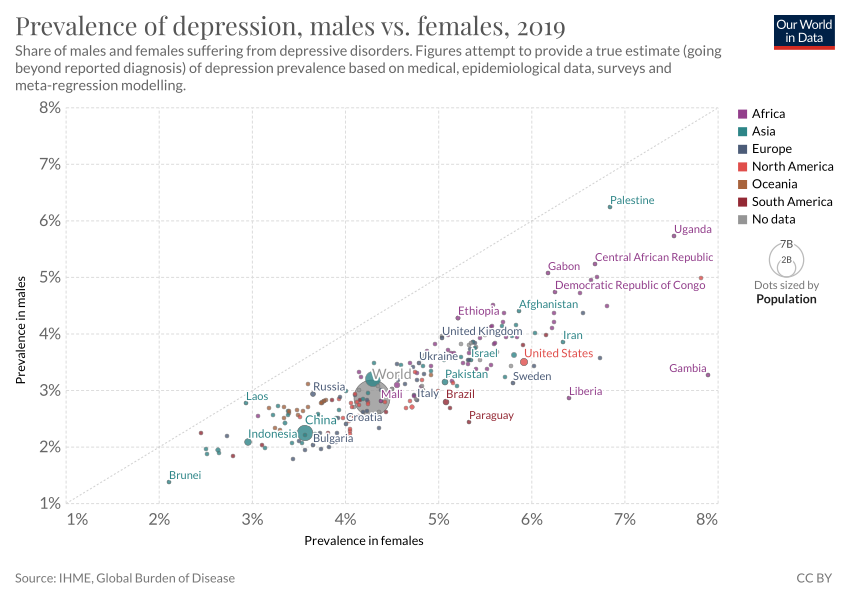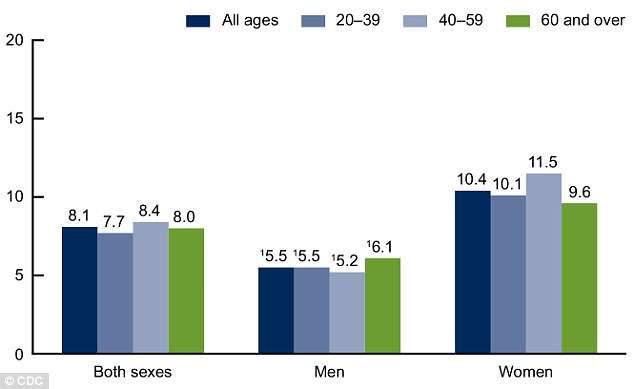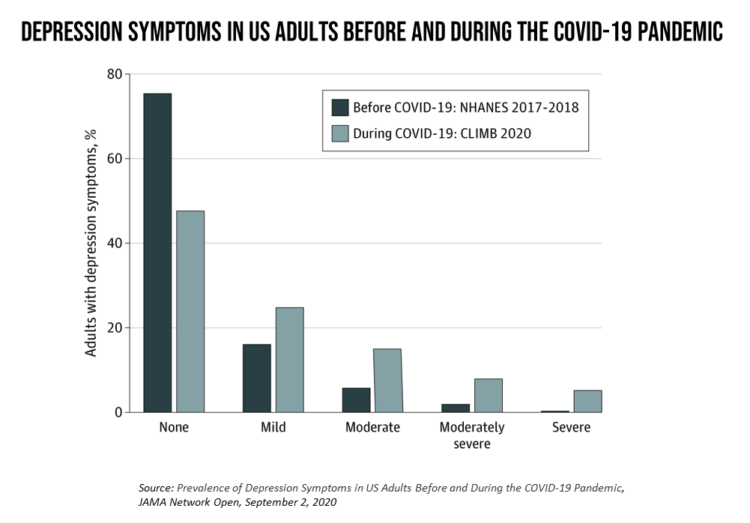Serious Mental Illness Prevalence Summary
Overall 5.2% of US adults aged 18 or older had some form of serious mental illness in the previous 12 months.
- Gender
- Highest incidence females at 6.5%
- Lowest incidence males at 3.9% (
- Difference between high and low 66.7%
Female Participants More Likely Than Males To Report That Their Lives Are Quite A Bit/extremely Stressful
A greater proportion of female participants than male participants reported that their lives were quite a bit or extremely stressful during the COVID-19 pandemic: 30.5% vs. 24.0%. Results from the 2018 CCHS indicate a similar pattern, where 22.9% of women and 19.1% of men reported that their lives were quite a bit/extremely stressful. While crowdsourced data are not directly comparable with population estimates from a sample survey like the CCHS, they are suggestive of an increase in life stress among both women and men during the COVID-19 pandemic.
Although the crowdsource did not collect information on marital status, the presence of children, or time use, it may be the case that some female participants reported higher levels of life stress than male participants because the quarantine has exacerbated the gender division of unpaid family work within households. Data from the 2015 General Social Survey on Time Use show that women spent more time, on average, than men on caregiving for children and unpaid household chores . With the closure of daycares, schools, and businesses like restaurants and drycleaners, women may be doing unpaid family work that their households would have previously outsourced to the paid economy, or with which their households would have previously received help from extended family or friends.
Top 10 Depression Statistics For 2021
- The disorder is most common in young adults aged 1825.
- About 31% of people living in poverty have been diagnosed with the disorder.
- Approximately one in eight women experience postpartum depression.
- As many as 37% of university and college students in the US have depression.
- An astounding 66.5% of trans teens have depression, statistics confirm.
- Depression rates are three times higher among people with HIV.
- An impressive 60% of children and adolescents with depression dont get any treatment at all.
- As many as 30.9% of survey respondents experienced symptoms of depression due to the COVID-19 pandemic.
- India is the most depressed country, with 6.5% of its population having some form of a serious mental disorder.
- Every day, approximately 110 Americans take their own life, and about 3,500 attempt to do so.
Also Check: Can You Be Happy If You Have Depression
Cisheteronormative Bias In Medicine
Implicit bias in medicine also affect the way lesbian, gay, bisexual, transgender patients, are diagnosed by mental health physicians. Due to internalized societal and medical bias, physicians are more likely to diagnosed LGBTQ+ patients with anxiety, depression and suicidality.
Gender Normativity and Bias in Medicine
It has also been observed that mental health professionals may pathologize the behaviors of individuals who do not conform to the practitioner’s gender ideals. Gender ideals have been found to influence understandings of mental health and illness at the stages of diagnosis, treatment, and evaluation of symptomology or of treatment.
The Developmental Pattern Of Gender Differences In Depression

Age was the strongest predictor of effect size, compared with all othermoderator variables. For both meta-analyses, the effect size peaked inadolescence but then declined and remained stable in adulthood, a finding thathas not been identified previously. The consistency of the findings across thetwo meta-analyses indicates that the findings are robust.
Adolescence
One of the goals of these meta-analyses was to ascertain the timecourse of the emerging gender difference in depression. In the majordepression meta-analysis, we could not examine the emergence of the genderdifference given that the youngest age in the studies was 12, when the ORwas already 2.37. These results differ from those of Hankin and colleagues , who found that thatthe gender gap in major depression emerged between ages 13 and 15 and thenwidened between ages 15 and 18. The odds ratio for the 1315 agegroup in our meta-analysis was already 3.02 and declined, not widened, to OR= 2.69 for ages 1619.
Taken together, our results provide powerful evidence that thegender difference in depression emerges earlier than previously thought , which has important implications for the timing ofpreventive interventions.
Adulthood
Future empirical directions
Theoretical implications
Recommended Reading: Can You Get Depressed After A Breakup
Serious Mental Illness Services Received Summary
Overall 65.5% of US adults with Serious Mental Illness received mental health services in the previous 12 months.
- Gender
- Highest incidence females at 70.5%
- Lowest incidence males at 56.5% (
- Difference between high and low 24.8%
Depression And Other Health Conditions
- It is estimated that depression is two to three times more common in people with a chronic physical health problem
- Nearly one-third of patients with major depressive disorder also have substance use disorders
- Research finds that 32-39% of people with anorexia nervosa, 36-50% of people with bulimia nervosa, and 33% of people with binge eating disorder are also diagnosed with major depressive disorder
Read Also: Guided Meditation For Anxiety And Depression 10 Minutes
Get Advice From The Verywell Mind Podcast
Hosted by Editor-in-Chief and therapist Amy Morin, LCSW, this episode of The Verywell Mind Podcast shares the value of undefining what it means to be a man, featuring author and actor Justin Baldoni.
Follow Now: Apple Podcasts / Spotify / / RSS
When someone cannot freely express their feelings, these emotions may emerge in other forms. For example, sadness that’s been pushed down might eventually bubble up to the surface as anger.
Research has indicated that men are often more likely to express depression in ways that differ from the more classic presentation. This difference may be one reason why depression in men is often missed or attributed to other causes.
Men may be more likely to express depression in the following ways:
- Misusing alcohol or other substances
- Irritability, frequent outbursts, or explosive anger
- Risk-taking
- Escapism
Controlling, violent, and unpredictable behavior can be a sign of a mental health condition such as depression or a substance use disorder in any person. However, mental illness does not justify abuse.
If you suspect a loved one needs treatment for depression, but they are abusive, you need to put your safety first. There are resources available that can help you stay safe and get your loved one the help they need.
How Is Depression Treated
Men often avoid addressing their feelings and, in many cases, friends and family members are the first to recognize that their loved one is depressed. It is important that friends and family support their loved one and encourage him to visit a doctor or mental health professional for an evaluation. A health professional can do an exam or lab tests to rule out other conditions that may have symptoms that are like those of depression. He or she also can tell if certain medications are affecting the depression.
The doctor needs to get a complete history of symptoms, such as when they started, how long they have lasted, how bad they are, whether they have occurred before, and if so, how they were treated. It is important that the man seeking help be open and honest about any efforts at self-medication with alcohol, non-prescribed drugs, gambling, or high-risk activities. A complete history should include information about a family history of depression or other mental disorders.
After a diagnosis, depression is usually treated with medications or psychotherapy, or a combination of the two. The increasingly-popular collaborative care approach combines physical and behavioral health care. Collaborative care involves a team of health care providers and managers, including a primary care doctor and specialists.
Also Check: Iop For Anxiety And Depression
Risk Factors And The Minority Stress Model
The minority stress model takes into account significant stressors that distinctly affect the mental health of those who identify as lesbian, gay, bisexual, transgender, or another non-conforming gender identity. Some risk factors that contribute to declining mental health are heteronormativity, discrimination, harassment, rejection , stigma, prejudice, denial of civil and human rights, lack of access to mental health resources, lack of access to gender-affirming spaces , and internalized homophobia. The structural circumstance where a non-heterosexual or gender non-conforming individual is embedded in significantly affects the potential sources of risk. The compounding of these everyday stressors increase poor mental health outcomes among individuals in the LGBTQ+ community. Evidence shows that there is a direct association between LGBTQ+ individuals’ development of severe mental illnesses and the exposure to discrimination.
In addition, there are a lack of access to mental health resources specific to LGBTQ+ individuals and a lack of awareness about mental health conditions within the LGBTQ+ community that restricts patients from seeking help.
The Disorder Is Most Common In Young Adults Aged 1825
Depression statistics for college students remark that young adults are very likely to experience depression. Namely, 10.9% of those aged 1825 experience it. Stress with school, financial problems, and moving away from friends and family do impact ones wellbeing and increase the likelihood of developing the disorder.
Also Check: Bible Verses When Feeling Depressed
Suicide Rates For Males And Females
Suicide rates have increased significantly for both young men and older men over the past 25 years . Suicide rates in men increase with advancing age .
These findings are corroborated in Will Courtenays Dying to be Men: Psychosocial, Environmental, and Biobehavioral Directions in Promoting the Health of Men and Boys. Courtenay cites the following suicide and death rates from the Centers for Disease Control .
|
17.5 |
We see that the suicide rate for males is higher than it is for females at all stages of life it is always in double digits for males and single digits for females. The lowest rate for males is higher than the highest rate for females. The mid-life years are difficult for both males and females, but the years after retirement show suicide rates dropping significantly for females but increasing dramatically for males. As populations age throughout the world, the issue of suicide in male seniors needs to be addressed seriously.
Ethnicity In The Us And Intersectionality

The extant literature indicates that the prevalence of major depressionin the United States varies both by gender and by ethnicity . However, few studies have tested whether genderdifferences in depression vary by ethnicity. The importance of this question ishighlighted in intersectionality theory, which emphasizes that all people belongto multiple social categories and that these categories are intertwined . According to this approach, thecategory of gender should not be considered in isolation, but should be analyzedas it intersects with other categories such as ethnicity. Empirical evidence forthese assertions is abundant space does not permit a thorough review here .
The limited research on ethnicity, gender, and depression in the UnitedStates does not indicate variation by ethnicity in the gender difference indepression . Nonetheless, other meta-analyses on genderdifferences for related constructs have found notable variations across U.S.ethnic groups. For example, a meta-analysis of gender differences in self-esteemfound a small difference favoring Caucasian males over Caucasian females,d = 0.20, but no gender difference for AfricanAmerican samples, d = 0.04 .Therefore, it was important to test whether gender differences in depressionvary across U.S. ethnic groups. We did not conduct analyses stratified byethnicity in other nations because ethnic groups are distinct in each countryand often are not reported.
You May Like: I M Sad And Depressed
Depression In Men Vs Women
Mental Health Education » Depression in Men vs. Women
Major depressive disorder, orMDD, is considered one of the morecommon mental health disorders. Yet despite this, the appearance of major depression can vary quite widely, with gender seeming to play a role in how this condition manifests itself. So, what are the characteristics of depression in men vs. women?
Four In Ten Adults In The Us Report Symptoms Of Depression Or Anxiety Because Of The Pandemic
Anxiety and depression statistics show that four in ten adults report having symptoms of depression and anxiety because of the pandemic, compared with one in ten adults in 2019. Moreover, 36% of adults in the US experience difficulty sleeping, 32% have problems eating, and 12% have increased alcohol consumption or substance use.
Also Check: I Think I May Be Depressed
Cdc Mental Health Statistics
Observations In the CDC findings, with very few exceptions, there is a clear trend between the beginning and end of the survey period with everything trending upwards for the 18-29, 30-39,40-50 age brackets. For participants in the 50-59, 60-69, 70-79, and 80+ age groups, there was either very little change, or in some cases an improvement.
NEGATIVE TRENDS
| 8.5 | 25 |
Here we see that while the actuals differ for both males and females the two biggest increases are
- Received therapy / counselling
- Needed but didnt get therapy / counselling
For the group which didnt get the therapy or counselling they believe they should have, the increase for males was 35.9% more than it was for the female respondents.
About 35% Of Adults Who Have Had A Major Depressive Episode Did Not Receive Treatment
An alarming number of adults who havent received treatment for depression may be explained the following way. First, those affected by depression may not want to report the disorder to healthcare professionals. Second, these people may be unaware of their condition. That said, US depression statistics also show that 65% of adults who have had a major depressive episode were tended to by a medical professional and received medication treatment.
Don’t Miss: Free Treatment For Depression And Anxiety
Womens Attitudes Toward Depression:
According to a Mental Health America survey on public attitudes and beliefs about clinical depression:
- More than one-half of women believe it is normal for a woman to be depressed during menopause and that treatment is not necessary.
- More than one-half of women believe depression is a normal part of aging.
- More than one-half believe it is normal for a mother to feel depressed for at least two weeks after giving birth.
- More than one-half of women cited denial as a barrier to treatment while 41% of women surveyed cited embarrassment or shame as barriers to treatment.
- In general, over one-half of the women said they think they know more about depression than men do.
The Percentage Of Adults Who Had Received Any Mental Health Treatment Varied By Age Group
Figure 1. Percentage of adults aged 18 and over who had received any mental health treatment, taken medication for their mental health, or received counseling or therapy from a mental health professional in the past 12 months, by age group: United States, 2019
Recommended Reading: Major Depressive Disorder Disability Rating
In Many Countries Fewer Than 10% Of The People Who Have Depression Receive Treatment
According to depression statistics, there are countries where an abnormally small number of people who suffer from depression receive proper treatment. As a side note, estimating the number of those getting treatment is challenging. Inaccurate medical assessments oftentimes drive numbers in statistics down.
Depression Is Less Prevalent Compared To Anxiety Disorders

According to anxiety statistics, worldwide, its prevalence is very high. In other words, generalized anxiety disorder , panic disorder, obsessive-compulsive disorder , phobia disorders, and post-traumatic stress disorder , along with other types of anxiety disorder, impact the lives of 284 million people.
You May Like: How To Deal With A Depressed Spouse
Depression Or Feelings Of Depression
Just over one in ten people had depression or feelings of depression in 2017-18, compared with 8.9% in 2014-15. While overall, females had depression or feelings of depression at a higher rate than males , the increase between 2014-15 and 2017-18 was especially evident amongst males aged 15-54 years.
| Age group |
|---|
| 8.6 |
,,,,,,,,],,,,,,,,],,,,,,,,],,,,,,,,]]
Anxiety and depression commonly occur together, with around 1.5 million Australians having both an anxiety-related condition and depression or feelings of depression in 2017-18 .
If Left Untreated Severe Depression Can Lead To Developing Serious Health Conditions
Many people around the world tend to overlook the disorder. It is worth noting that, if left untreated or undertreated, it can bring about other conditions. That said, according to the World Health Organization, one could look into a number of treatmentsmedication, diet, therapy, exercisingto find the ones that work for them and decrease the risk of developing other conditions.
Don’t Miss: Can You Relapse Into Depression